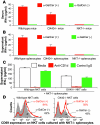OX40 ligand expressed by DCs costimulates NKT and CD4+ Th cell antitumor immunity in mice
- PMID: 17975668
- PMCID: PMC2045612
- DOI: 10.1172/JCI32693
OX40 ligand expressed by DCs costimulates NKT and CD4+ Th cell antitumor immunity in mice
Abstract
The exceptional immunostimulatory capacity of DCs makes them potential targets for investigation of cancer immunotherapeutics. We show here in mice that TNF-alpha-stimulated DC maturation was accompanied by increased expression of OX40 ligand (OX40L), the lack of which resulted in an inability of mature DCs to generate cellular antitumor immunity. Furthermore, intratumoral administration of DCs modified to express OX40L suppressed tumor growth through the generation of tumor-specific cytolytic T cell responses, which were mediated by CD4+ T cells and NKT cells. In the tumors treated with OX40L-expressing DCs, the NKT cell population significantly increased and exhibited a substantial level of IFN-gamma production essential for antitumor immunity. Additional studies evaluating NKT cell activation status, in terms of IFN-gamma production and CD69 expression, indicated that NKT cell activation by DCs presenting alpha-galactosylceramide in the context of CD1d was potentiated by OX40 expression on NKT cells. These results show a critical role for OX40L on DCs, via binding to OX40 on NKT cells and CD4+ T cells, in the induction of antitumor immunity in tumor-bearing mice.
Figures





Comment in
-
OX40 signaling directly triggers the antitumor effects of NKT cells.J Clin Invest. 2007 Nov;117(11):3169-72. doi: 10.1172/JCI33976. J Clin Invest. 2007. PMID: 17975660 Free PMC article.
References
-
- Banchereau J., et al. Immunobiology of dendritic cells. Annu. Rev. Immunol. 2000;18:767–811. - PubMed
-
- Steinman R.M. Some interfaces of dendritic cell biology. APMIS. 2003;111:675–697. - PubMed
-
- Sugamura K., Ishii N., Weinberg A.D. Therapeutic targeting of the effector T-cell co-stimulatory molecule OX40. Nat. Rev. Immunol. 2004;4:420–431. - PubMed
-
- Salek-Ardakani S., Croft M. Regulation of CD4 T cell memory by OX40 (CD134). Vaccine. 2006;24:872–883. - PubMed
-
- Croft M. Co-stimulatory members of the TNFR family: keys to effective T-cell immunity? Nat. Rev. Immunol. 2003;3:609–620. - PubMed
Publication types
MeSH terms
Substances
LinkOut - more resources
Full Text Sources
Other Literature Sources
Molecular Biology Databases
Research Materials

